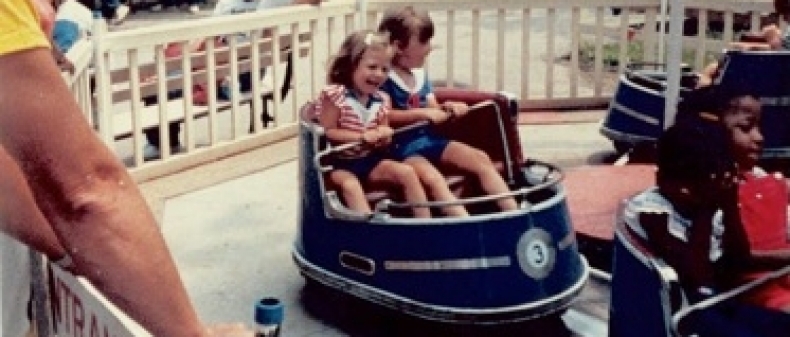
Trying to pin down any concrete memories of Boblo Island feels a lot like trying to catch baby eels with my hands in dark water at night. There is something there, alive and full of muscle, but almost impossible to catch hold of. I remember the heat of the summer, the sensation of sweat and sugar beading together on my upper lip as I wandered the amusement park eating cotton candy. I remember the swooping, ecstatic nausea of riding the pirate ship. Above all else I remember the sense of suspended time, of somehow being outside the regular world in a pocket dimension that seemed to distill every amusement park and county fair experience in the world.
* * *
BOBLO, a performance produced by the collective Kitchenband, ran from November 22nd to December 2nd at The Theatre Centre (the final performance in the show’s run was, in fact, the last performance that will be held at the Theatre Centre’s now-former home in the Great Hall before it moves to its new location next year), came as close I have ever experienced to touching my complex and broken memories of the defunct theme park, Boblo Island. Created by Erin Brandenburg and Andrew Penner, and directed by Steven McCarthy, the genius of BOBLO was that it somehow managed to distill the surreality of memory surrounding the place, the sensory, impressionistic recollections that fit together ill and seem more impossible the more time that passes.
BOBLO combined music and drama, live performances and recordings, multiple levels of the theatre space, and intricate lighting and projections. The end result was less a clear narrative and more a combination of impressions, relics from the park and more esoteric historical facts about the island’s history interwoven in a show that interrogated the very construction of memory.
Boblo Island opened as an amusement park in 1898, but the island itself was much more than simply the park. Located on the same little spit of land was the very last stop on the underground railroad, a significant relic from both American and Canadian history. A stone lighthouse that dates back to 1836 marks the beginning of the Detroit River becomming a significant channel for ships. One of the defining features of my own childhood is watching huge transport ships pass right in front of my house from the huge, bay windows in my parents’ living room. It was of strategic importance during both the Upper Canada Rebellion and the War of 1812. It has been a site of Catholic Missions as well as an armoury.
Reaching out to interact with this history, BOBLO was full of ghosts. The actors took on the roles of students going on school trips to Boblo island, former employees of the park, a woman who had drowned in the icy waters of the Detroit river surrounding the island, the spirit of another boy lost out on the ice and his father who held seances in an attempt to contact him — all characters who, by death or simply obscurity, no longer existed. They sometimes spoke directly to the audience, sometime through the crackle of a CB radio, and sometimes through several layers and filters of recording, their voices rendered small and tinny, far away.
In addition to actors taking on the role of ghosts, their presence was augmented by the use of projections. The two-story space was surrounded by floor-to-ceiling sheets of translucent plastic sheeting, which could be lit to be both entirely transparent or partially opaque. Faintly glowing, moving silhouettes were projected into the plastic, giving the impression that spirits were walking and playing in the upper level that ringed the theatre. If had the distinct effect of making it seems that part of the audience was made up of ghosts.
BOBLO was a haunted show. Not only did the characters take on the form of poltergeists, but the whole performance was also haunted by the spectre of the amusement part of Boblo Island itself. The odours from the concession stand wafted into the theatre, so that the while show smelled like ghostly popcorn and sticky-sweet pop. Commercials for the park from the late 80s were played on a vintage television on the stage. At once point, all of the performers stood and spoke over each other, in a babble, of their personal impressions and memories of Boblo Island, some vast and specific, other small and vague, like singer Anna Atkinson, who admitted that she had never been to the park because she was the only one of her siblings to attend French Immersion, and therefore never went on a field trip to the park. Her only memory was of a sense of unfairness and longing.
* * *
The Boblo Island amusement park closed in September of 1993, just two months after I turned ten. The year before, in 1992, my brother, father and I spent a ridiculous amount of time at the park. My dad was taking a year off; this was years before he would be diagnosed with bipolar disorder, so we only knew he was having a difficult year and had chosen not to work. On his good days, he would get bored at home and take my brother and I out of school by late morning, for an “appointment.” We would get Burger King drive-through and spend the rest of the day at Boblo, riding the tilt-a-whirl and the octopus, or just walking around the park. By the next year, my father was working again and the park has been sold to developers. The rides were dismantled, and new “resort homes” were being built, a new ferry service arranged for the residents.
The loss of Boblo profoundly changed the geography of my childhood. It changes the smell of the air of the town I grew up in, which no longer carried the scents of sugar and popcorn and vomit every time a breeze blew over from the island. The town I grew up in, Amherstburg, Ontario, is still a hellmouth, one of those places that contains a strange old magic that is hard to describe, and Boblo encapsulated so much of that magic. The dock where the smallest of the ferries to the park would depart from Amherstburg, had the entrance boarded up and filled with concrete, but it still exists. To this day, the clearest landmark for me to describe how to get to my parents’ house is that it is a kilometre passed the Boblo dock.
* * *
While BOBLO was certainly an intensely dramatic performance, it was also filled with music. Music was the primary language through which the show’s narrative was conveyed, the uniting force that connected the mixed media, movement and dance, and dramatic elements. Throughout the show, a group of musicians remained (for the most part) in the same section of the stage, their own stage within a stage, but the narrative location of the band changed as the show progressed. At some points, they provided the show’s soundtrack, contextualizing and rephrasing the action. Sometimes the music was used as a kind of call and response, interweaving with the actors’ spoken words. And sometimes the band stood in for a band on the island itself, the music becoming a ghost of what would have been played during the summer evening dances held on the Island.
Co-creator and musician Andrew Penner served as a kind of guide throughout the performance, like Charon with a guitar and mic instead of a boat and pole. His role was that of narrator after a fashion, providing tidbits of Boblo’s history, guiding the audience through transitions of time and space. His voice was the golden thread that the audience followed through the labyrinth. The music itself was varied but always haunting, composed of odes to Boblo itself, meditation on the hawks that circle the island, or dance hall classics. At once point, Penner led the audience in an upbeat sing-along about the glory days of the amusement park; earlier, Anna Atkinson sand into a bullhorn, her ethereal voice distorted and amplified, becoming both panicked and ghostly in the process.
At first, it seemed like themes of decay and confinement would dominate BOBLO. The predominant metaphor was the nature of memory as both a tool of preservation and a prison. Whether what was trapped was the mourning of a father for his lost sun, the memory of a drowned woman trapped in the lake where she died, or the voices of the actors trapped in radio frequencies. At one moment, and old Faygo ad projected into a cardboard box, so that when it opened it seems to be trapped inside. After it played, the box was then closed back up, the memory put away and sealed back in.
But as the show unfolded, the nature of memory and the confining structures around it began to fail. The various time frames that separated the characters began to dissolve, and eventually, the ghosts all met. Even the most sad and restrained of the spirits was coaxed into dancing and partying with the rest, and in that moment, with the dissolution of the structure of memory, there was only presence, immediacy and celebration. From the concession stand in the lobby, I could smell popcorn.
____
Natalie Zina Walschots is a poet and music writer based in Toronto, Ontario. Her second book of poetry, DOOM: Love Poems for Supervillains, was published by Insomniac Press this spring. You can follow her on Twitter at @NatalieZed.
For more, follow us on Twitter at @torontostandard, and subscribe to our newsletter.












